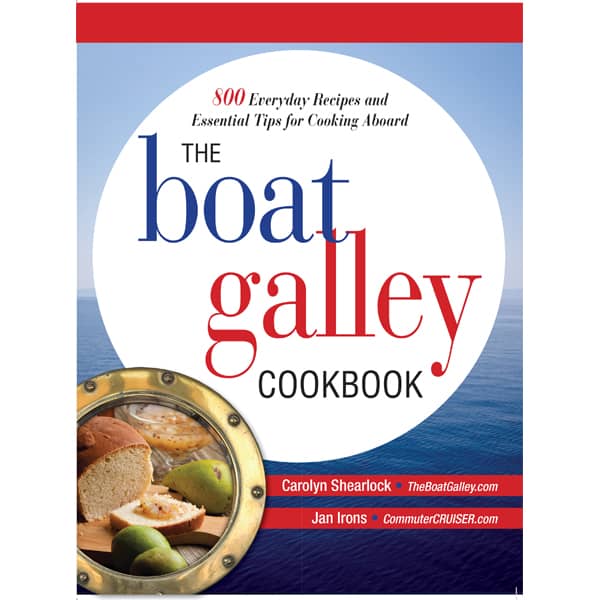
Using a galley oven is different than one on shore. A boat’s motion — even at anchor — can make baking with a marine stove seem more challenging than in a home oven. The tips below can eliminate many of the potential problems.
The first rule of baking in a boat oven is to always use your stove gimbals to keep your pans level in the oven. In simple terms, the gimbal is a pivot point running fore and aft that lets your stove/oven stay level, even when the boat is heeled or rolling.
In using a gimbaled stove, there are two important points to keep in mind:
- Most gimbal systems will let the stove swing 20 to 30 degrees, at which point the stove and oven will crash against the back wall. That’s not good for the stove, nor for what you have baking in the oven.
- If you are using the gimbal and have a pot on the stove top, the stove isn’t going to stay level. It’s going to tilt in the direction of the pan. This will cause lopsided cakes and other items won’t cook evenly since one side will be thicker than the other.
Thus, if conditions are rough, you need to check the swing of the stove before mixing something up. Release the gimbal and watch the stove swing for several minutes — hopefully through what feels like the equal of the worst movement the boat is experiencing. If the stove crashes into the wall (or other stop), forget about baking (or any other cooking) and find something cold to eat.
If you’re baking and cooking something on the stove top at the same time, you’ll have to equalize the weight on both sides of the pivot point. For example, if you’re cooking something on a front burner, fill the teakettle or a saucepan with water and set it on an unlit back burner so that the oven will stay level (otherwise the whole stove and oven will tilt, causing pans to slide and cakes to turn out uneven).
While there are pot restraints for cooking on the stove top, I’ve never seen any type of pan restraints for the oven. If you are baking while underway or in a rolly anchorage, you’ll need to wedge the pan in place so it won’t slide as the boat moves, in addition to using the gimbal to keep things level. I found that I could clip small binder clips (make sure they’re 100% metal with no plastic!) to the oven rack to hold a pan in place (if the wires in your rack are too small for the clip to hold, wrap the wire with a few layers of aluminum foil). Some cruisers wedge their baking pans in with additional pans or crumpled aluminum foil, but these interfere with the heat and air flow in the oven and can lead to hot spots. The binder clips can also be used to keep a baking stone from sliding.
Finally, a silicone trivet or a couple of silicone pot holders work well as a cooling rack in a boat galley. Not only are they nonskid – a huge plus – but the texture allows air flow under the pan similar to a wire cooling rack. They are easy to stow, quiet, and serve triple duty — pot holders/trivet, cooling rack and a jar opener!

Carolyn Shearlock has lived aboard full-time for 17 years, splitting her time between a Tayana 37 monohull and a Gemini 105 catamaran. She’s cruised over 14,000 miles, from Pacific Mexico and Central America to Florida and the Bahamas, gaining firsthand experience with the joys and challenges of life on the water.
Through The Boat Galley, Carolyn has helped thousands of people explore, prepare for, and enjoy life afloat. She shares her expertise as an instructor at Cruisers University, in leading boating publications, and through her bestselling book, The Boat Galley Cookbook. She is passionate about helping others embark on their liveaboard journey—making life on the water simpler, safer, and more enjoyable.
Simplify meal prep on board with proven strategies for provisioning, maximizing fridge space, and cooking delicious meals aboard your boat.










Jake Krige says
Ilke Krige
Joysealife.com says
I like the idea of binder clips. I use them to keep chip bags closed, so I already have some on the boat.
Carol Dean says
And may I add, check your pan size before you bake….I had a pan of home made pecan glazed sweet rolls, perfectly raised, ready to pop in my oven that wouldn’t fit….do you know how difficult it is to tranfer unbaked glazed dough?
The Boat Galley says
Oh geez. I’ve had to transfer simple things but luckily figured out what pans don’t fit (and gave them away) before I had bread dough in one.
Dave Skolnick says
The issue with balanced cooktops is why you see so many two burner cookers on offshore passagemakers. I sure miss extra burners (I had a six-burner commercial cooktop in my last house). My observation is on boat sized cookers the difference between two and three (or four) burners just isn’t important.
I absolutely agree with Carolyn about letting the oven gimbal while baking. I do suggest locking the gimbal when you are ready to take things out. The door throws everything off. It only takes one hot lasagna in your lap to learn that lesson.
Carolyn Shearlock says
Good point Dave to lock it when you take things out. And being extra, extra careful as you open that door and have a hand ready to catch anything that might slide out.
Sarah Johnson says
You guys are fancy! I don’t have an oven in my galley, but I did once bake a cake inside the nesting pots you recommend.
Chrystal Lakeway Henthorne says
Any microwave hints or recipes?
The Boat Galley says
I mostly used the microwave for popcorn (okay, Dave was the appointed popcorn maker), or reheating leftovers — especially when underway. The ones with turntables can get “stuck” if the boat is rolling some, so you have to be careful if you hear a change in sound and go check it. I don’t like to boil water in the microwave underway as it can slosh out and burn your hand when you reach in (I learned that lesson the hard way . . . )
Sandra Asbe says
We make toast in our oven. The only thing is, we have to let the door stand open or the broiler goes off. This is sorta tricky when underway!
Caron Butler Armstrong says
This might also be helpful:
https://g.co/kgs/7TmTB6
Anonymous says
Debbie Jackson
Leslie La Bute says
I use pizza stones in my oven for even heat, Toaster oven size.
https://amzn.to/3msiJpp
I store them in the oven. Binder clips are attached to the oven rack so that a pan doesn’t slide out when opening the oven. Careful they get hot too.
Carolyn Shearlock says
Yep, I do exactly the same thing.